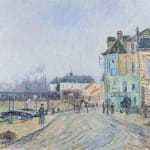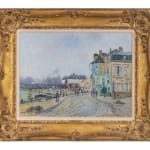Gustave Loiseau
Loiseau’s art is often described as pre-eminent among the second wave of artists that emerged after the first Impressionists. He is best remembered for his scenes of evocative landscapes and bustling streets in and around Paris and neighbouring towns and tributaries of the Seine. Yet, Loiseau’s art cannot be considered solely impressionistic as he verged towards Pointillism: the surfaces of his paintings contain intricate geometric webs of brushstrokes that abstract in close proximity. Nevertheless, essential to his practice were his forays out of the studio in order to capture the landscape as he saw it.
Loiseau was born on October 3, 1865 in Paris and attended the Ecole des Arts Decoratifs in Paris.Seeking a location where he could concentrate on his love of landscape painting en plein air, Loiseau travelled to the village of Pont-Aven in Brittany, a well-known artist colony. There, he met Henry Moret, Maxime Maufra, and other artists of the Pont-Aven School. He also learned a great deal from Paul Gauguin (French, 1848-1903) who had returned to Pont-Aven in 1890 from his first trip to Tahiti; but his early work was mainly influenced by Camille Pissaro and Alfred Sisley. Loiseau took part in the 1890 Impressionists exhibition and from 1893 showed at the Salon des Indépendants. The leading art collector and primary patron of the Impressionists, Paul Durand-Ruel, put the artist under his contract in 1894. This success enabled Loiseau to travel extensively to discover different regions of France, spending summers in Normandy, Brittany, and occasionally, the Dordogne, and returning in winter to the Isle-de-France. His paintings are faithful witnesses of his travels.
His work is represented in major museum and personal collections such as the Metropolitan Museum of Art in New York, the Museo Nacional Thyssen-Bornemisza in Madrid and the Tokyo Fuji Art Museum, among many other world institutions.
In 2003 his work was represented posthumously in the collective thematic exhibition Between Heaven and Earth: Camille Pissarro and the Painters of the Oise Valley ( Entre ciel et terre, Camille Pissarro et les peintres de la vallée de l’Oise) at the Musée Tavet-Delacour in Pontoise.
Loiseau’s work was also shown in solo exhibitions: the Salon des Indépendants devoted a retrospective to 14 of his works in 1936; the Musée Pissarro in Pontoise held an exhibition dedicated to Loiseau’s works in 1981; and in 2001 the museum of Pont-Aven mounted the retrospective Gustave Loiseau and Brittany (Gustave Loiseau et la Bretagne).
Pontoise is in the Val d'Oise department of the Paris-Isle-of-France region.The town is on the banks of the river Oise, hence the name Pont-Oise, the bridge over the river Oise. Pontoise is served by Pontoise station, a terminus on Paris line and an intermediate terminus for suburban trains originating from Gare Saint-Lazare as well as a terminus for suburban trains from Gare du Nord.
Selected collections:
Musee d’Orsay, Paris, France
Musee Lambinet, Versailles, France
Collection Carmen Thyssen-Bornemisza, Madrid, Spain
Hecht Museum, Israel
Tokyo Fuji Art Museum, Japan
Musee de L’Hermitage, Saint Petersburg
Albright-Knox Art Gallery, Buffalo, New York, USA
Art Institute of Chicago, Chicago, USA
Museum of Fine Arts, Boston Massachusetts, USA
Metropolitan Museum of Art, New York, USA
San Diego Museum of Art, San Diego, USA
Loiseau’s works are being materially re-evaluated and high quality works now regularly make £200,000 to £400,000 at auction.
Provenance
The Artist
Galerie Durand-Ruel, Paris, acquired from the Artist, April 11, 1907
Mr. Kronberg Chevalier, Legion of Honour, France (a dealer who purchased art for the Gardner Museum, Boston and who was an artist (The Pink Sash, Met)), acquired directly from the above, October 2, 1923



